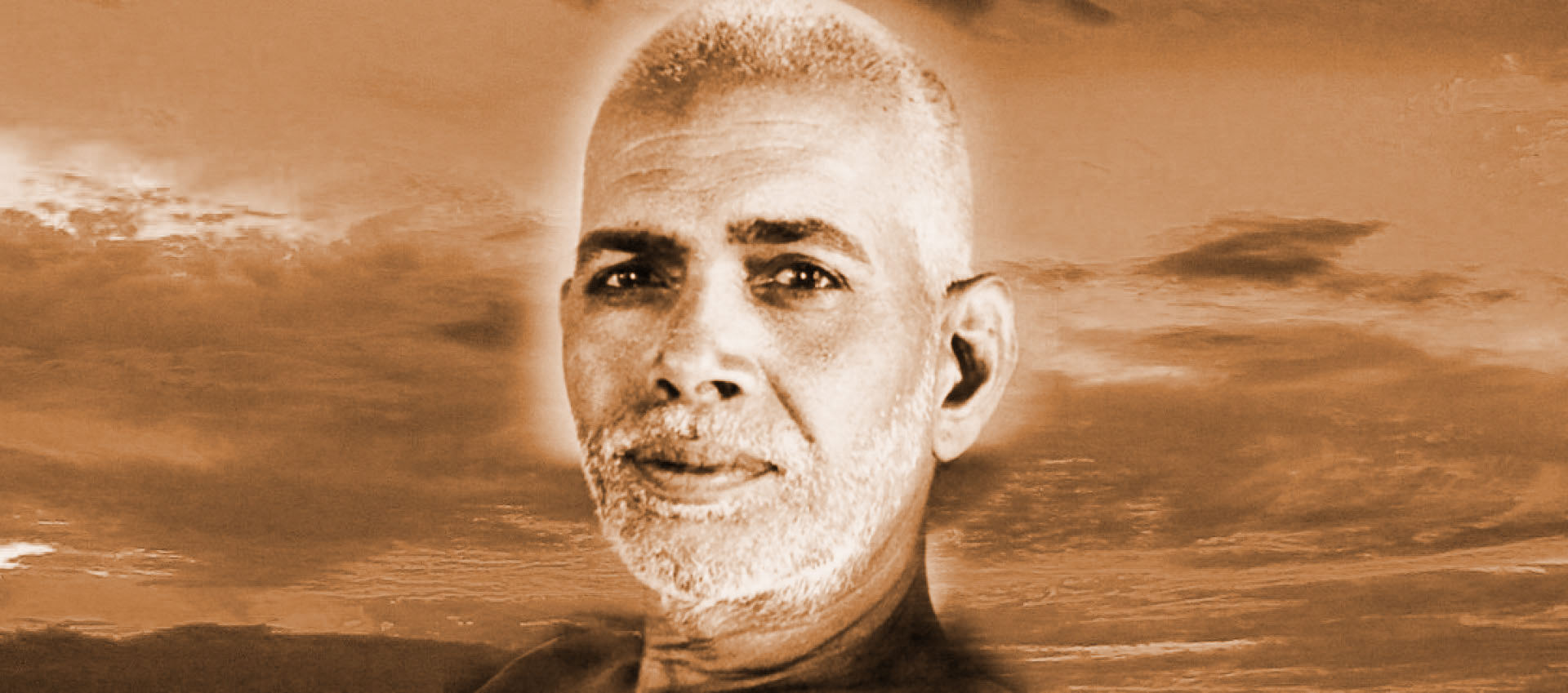
What is Meditation? How to do it? (5)
~~~~~~~
Talk 293.
Mr. K. K. V. Iyer: There is no way found to go inward by means of meditation.
M.: Where else are we now? Our very being is that.
D.: Being so, we are ignorant of it.
M.: Ignorant of what, and whose is the ignorance? If ignorant of the Self, are there two selves?
D.: There are no two selves. The feeling of limitation cannot be denied. Due to limitations….
M.: Limitation is only in the mind. Did you feel it in deep sleep? You exist in sleep. You do not deny your existence then. The same Self is now and here, in the wakeful state. You are now saying that there are limitations. What has now happened is that there are these differences between the two states. The differences are due to the mind. There was no mind in sleep. whereas it is now active. The Self exists in the absence of the mind also.
D.: Although it is understood, it is not realized.
M.: It will be by and by, with meditation.
D.: Meditation is with mind and how can it kill the mind in order to reveal the Self?
M.: Meditation is sticking to one thought. That single thought keeps away other thoughts; distraction of mind is a sign of its weakness. By constant meditation it gains strength; that is to say, its weakness of fugitive thought gives place to the enduring background free from thoughts. This expanse devoid of thought is the Self. Mind in purity is the Self.
~~~~~~~
Talk 294.
Mr. Parkhi: How is meditation to be practised?
M.: Meditation is, truly speaking, Atmanishtha (to be fixed as the Self). But when thoughts cross the mind and an effort is made to eliminate them the effort is usually termed meditation. Atmanishtha is your real nature. Remain as you are. That is the aim.
D.: But thoughts come up. Is our effort meant to eliminate thoughts only?
M.: Yes. Meditation being on a single thought, the other thoughts are kept away. Meditation is only negative in effect inasmuch as thoughts are kept away.
D.: It is said Atma samstham manah krtva ( fixing the mind in the Self). But the Self is unthinkable.
M.: Why do you wish to meditate at all? Because you wish to do so you are told Atma samstham manah krtva ( fixing the mind in the Self); why do you not remain as you are without meditating? What is that manah (mind)? When all thoughts are eliminated it becomes Atma samstha ( fixed in the Self).
D.: If a form is given I can meditate on it and other thoughts are eliminated. But the Self is formless.
M.: Meditation on forms or concrete objects is said to be dhyana, whereas the enquiry into the Self is vichara (enquiry) or nididhyasana.
~~~~~~~
Talk 297.
Mr. Cohen asked: Meditation is with mind in the jagrat (waking) state. There is mind in dream also. Why is there no meditation in dream? Nor is it possible?
M.: Ask it in the dream.
After a short silence Sri Bhagavan continued: You are told to meditate now and find who you are. Instead of doing it you ask “Why is there no meditation in dream or in sleep?” If you find out for whom there is jagrat (waking), it will be clear that dream and sleep are also for the same one. You are the witness of jagrat (waking), svapna (dream) and sushupti (sleep) – rather, they pass before you. Because you are out of meditation now, these questions arise. Stick to meditation and see if these questions arise.
~~~~~~~
Talk 310.
Mr. Greenlees:
D.: Work leaves no time for separate meditation. Is the constant reminder “I am”, trying to feel it while actually at work, enough?
M.: It will become constant when the mind becomes strengthened. Repeated practice strengthens the mind; and such mind is capable of holding on to the current. In that case, engagement in work or no engagement, the current remains unaffected and uninterrupted.
D.: No separate meditation is necessary?
M.: Meditation is your true nature now. You call it meditation, because there are other thoughts distracting you. When these thoughts are dispelled, you remain alone, i.e., in the state of meditation free from thoughts; and that is your real nature which you are now attempting to gain by keeping away other thoughts. Such keeping away of other thoughts is now called meditation. When the practice becomes firm, the real nature shows itself as the true meditation.
Other thoughts arise more forcibly when you attempt meditation.
There was immediately a chorus of questions by a few others.
Sri Maharshi continued: Yes, all kinds of thoughts arise in meditation. It is but right. What lies hidden in you is brought out. Unless they rise up, how can they be destroyed? They therefore rise up spontaneously in order to be extinguished in due course, thus to strengthen the mind.
~~~~~~~
Talk 348.
D.: This third visit to Tiruvannamalai seems to have intensified the sense of egoism in me and made meditation less easy. Is this an unimportant passing phase or a sign that I should avoid such places hereafter?
M.: It is imaginary. This place or another is within you. Such imaginations must end so that the places have nothing to do with the activities of the mind. Even your surroundings are not of your own accord; they are there as a matter of course. You must rise above them and not get yourself involved.
~~~~~~~
Talk 427.
D.: In the practice of meditation are there any signs of the nature of subjective experience or otherwise, which will indicate the aspirant’s progress towards Self-Realization?
M.: The degree of freedom from unwanted thoughts and the degree of concentration on a single thought are the measure to gauge the progress.
~~~~~~~
Talk 580.
D.: How is one to meditate?
M.: What is meditation? It is commonly understood to be concentration on a single thought. Other thoughts are kept out at that time. The single thought also must vanish at the right time. Thought-free consciousness is the goal.
~~~~~~~
Talk 155.
Mr. Cohen: I get into meditation and reach a point which may be called peace and a contemplative mood. What should be the next step?
M.: Peace is Self-Realization. Peace need not be disturbed. One should aim at Peace only.
D.: But I do not have the satisfaction.
M.: Because your peace is temporary. If made permanent it is called Realization.
~~~~~~~
Talk 214.
Mr. Eknatha Rao, a frequent visitor, asked:
D.: Are there not modulations in contemplation according to circumstances?
M.: Yes. There are; at times there is illumination and then contemplation is easy; at other times contemplation is impossible even with repeated attempts. This is due to the working of the three Gunas (qualities in nature).
D.: Is it influenced by one’s activities and circumstances?
M.: Those cannot influence it. It is the sense of doership – kartrutva buddhi – that forms the impediment.
~~~~~~~
Talk 220.
Mr. B. C. Das, the Physics Lecturer, asked:
D.: Contemplation is possible only with control of mind and control can be accomplished only by contemplation. Is it not a vicious circle?
M.: Yes, they are interdependent. They must go on side by side. Practice and dispassion bring about the result gradually. Dispassion is practised to check the mind from being projected outward; practice is to keep it turned inward. There is a struggle between control and contemplation. It is going on constantly within. Contemplation will in due course be successful.
D.: How to begin? Your Grace is needed for it.
M.: Grace is always there. “Dispassion cannot be acquired, nor realization of the Truth, nor inherence in the Self, in the absence of Guru’s Grace,” the Master quoted.
Practice is necessary. It is like training a roguish bull confined to his stall by tempting him with luscious grass and preventing him from straying.
~~~~~~~
Talk 306.
D.: There is something concrete necessary to meditate upon. How shall we meditate upon ‘I’?
M.: We have become rooted in forms and so we require a concrete form for meditating upon. Only that which we contemplate will in the end remain over. When you contemplate the other thoughts disappear. So long as you need to contemplate there are other thoughts. Where are you? You contemplate because you exist. For the contemplator must contemplate. The contemplation can only be where he is. Contemplation wards off all other thoughts. You should merge yourself in the source. At times we merge in the source unconsciously, as in sleep, death, swoon, etc. What is contemplation? It is merging into the source consciously. Then the fear of death, of swoon, etc. will disappear, because you are able to merge into the source consciously.
~~~~~~~
Talk 367.
A lady, a casual visitor then taking leave, was almost on the point of bursting into tears; she asked; I know that mukti (liberation from bondage) is impossible in one life. Still may I not have peace of mind in this life?
The Master looked at her very kindly and said smiling softly: Life and all else are in Brahman alone. Brahman is here and now. Investigate.
D.: I am practising meditation for a number of years. Yet my mind is not steady and cannot be brought to bear on meditation.
M.: Bhagavan again looked steadily at her and said: “Do it now and all will be right.”

